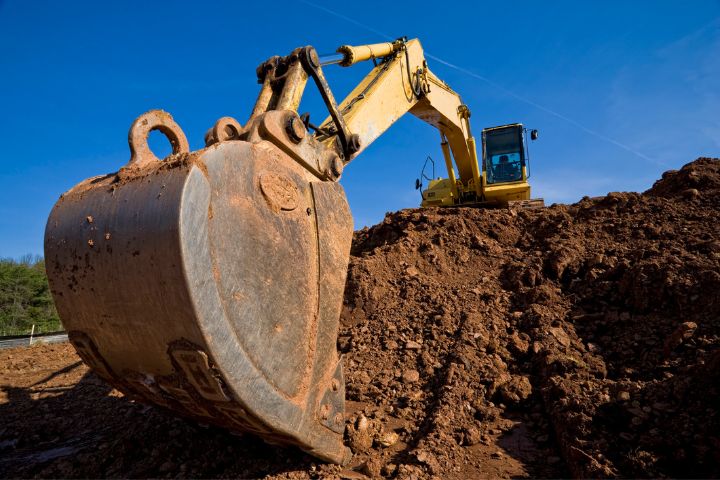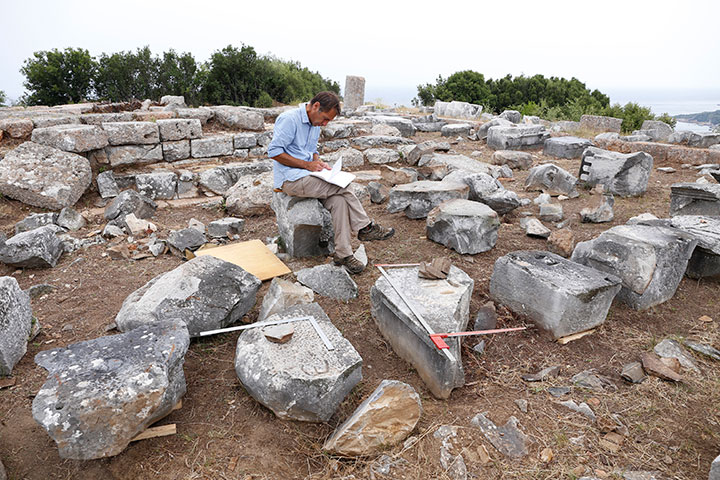Five newly awarded sustainability catalyst grants will support a variety of projects designed to advance technical and behavioral interventions toward greater sustainability. The projects are funded by the Graham Sustainability Institute.
Engaging researchers from nine units across the University of Michigan and several other academic institutions, along with multisectoral partners, the projects will explore community solar, agrivoltaics, carbon-neutral building materials, aviation fuel waste reduction, and sustainable archeology.
“I am particularly excited by the possibility of applying the concept of sustainability to the preservation of archaeological sites,” said Christopher Ratté, professor of Classical Studies at UM-Ann Arbor. Ratté, an archaeologist specializing in western Anatolia, is leading a catalyst project that will center sustainability and community engagement in his ongoing work in Notion, Turkey.
“We hope to use this project to model and explore sustainable development strategies that could be more widely used by the local community.”
Heather Dawson, program director and professor of Biology at UM-Flint, is the principal investigator of a community solar feasibility assessment for Flint, Michigan. “The idea of a solar cooperative in Flint started with environmental leaders in the community,” said Dawson. “It’s a great potential pathway to decrease residents’ energy burdens and increase sustainability.”
“We hope the partnership between community-based leaders and faculty and students at U-M and Kettering University, which is supported by our catalyst grant, will produce a clear picture of how a solar cooperative would mitigate some of Flint’s energy justice challenges.”
Since 2017, more than 30 projects have received sustainability catalyst grant support from Graham for small-scale, collaborative, interdisciplinary sustainability research intended to develop partnerships and lay the groundwork for user-driven research. Sustainability catalyst grants are open to all faculty and researchers across U-M’s three campuses. Each of the five featured research teams will receive $10,000.
“Graham’s catalyst grant program supports faculty in developing the tools, capacity, and plans to meet end-user needs, a core part of the Graham Sustainability Institute’s mission,” said Jennifer Haverkamp, Graham Family Director. “The projects chosen for funding reflect the diverse talents of U-M faculty and benefit the communities and partners they serve. We are pleased to contribute to their success.”
To learn more about the new projects, read on and visit the project web pages linked below.
Empowering Flint Solar
Exploring a Cooperative Model to Increase Energy Sovereignty

Flint residents have one of the highest energy burdens in Michigan, spending more of their income on energy bills than most of the rest of the state. Community-level renewable energy has the potential to make energy more affordable for Flint residents while improving environmental health and promoting environmental justice.
With this in mind, a vision for a solar cooperative in Flint emerged from an energy justice strategy meeting led by community organizations with participation from neighborhood leaders, community members, public health department staff, and faculty from UM-Flint and Kettering University. In a solar cooperative, customers buy shares in solar arrays placed at a community site and receive utility bill credit for the power generated by their panels.
This research team will assess the feasibility of that vision, positing that a solar cooperative would synergize existing work in Flint to improve climate resilience, increase energy democracy, and bolster the creation of an environmental sustainability plan. The catalyst grant will support benchmarking of comparable community developments and enable the research team to establish and compensate a steering committee composed of environmental, community, and municipal leaders, residents from neighborhoods with space for a solar cooperative, and technical experts.
The steering committee will represent the views and priorities of end-users and identify obstacles and opportunities. Based on their contributions, the project team will produce a list of end-user priorities and views and a list of potential roadblocks and remedies. The researchers hope their efforts will help Flint make tangible progress toward community solar.
Project team: Heather Dawson, PI (Biology | UM-Flint); Mihai Burzo, Co-I (Engineering | UM-Flint); Pamela Carralero, Co-I (Environmental Humanities | Kettering University); Shirl Donaldson, Co-I (Digital Manufacturing Technology, | UM-Flint); Karl Hoesch, Co-I (SEAS | U-M Ann Arbor); Mona Munroe-Younis, Co-I (Environmental Transformation Movement of Flint); Stephen Turner, Co-I (Computer Science | UM-Flint); Nayyirah Shariff (Flint Rising)
Eliminating the Tradeoffs Between Farming and Solar Energy Development
Testing Semi-Transparent Solar Cell Technology at U-M’s Campus Farm

Solar photovoltaic technology is experiencing explosive growth to meet current and future energy needs. But solar energy production requires more land than comparable fossil fuel energy production. As the demand for solar increases, so will the demand for land. Unless farming and energy production can occur simultaneously, agriculturally valuable land could be in jeopardy. While combined “agrivoltaic” development is possible, research shows that conventional opaque solar arrays installed on farmland often decrease crop yields.
This catalyst grant will support a transformative concept of land-use sharing between solar power generation and agriculture that removes compromises where one use negatively impacts the other. The research will focus on Michigan crops that are economically important, providing a framework that can be expanded to other types of crops, climate zones, and land use. By combining expertise in crop growth and ecosystem health with new semi-transparent solar cell technology developed by the researchers, the team aims to develop new products for specific agricultural applications adapted to the regions in which they are applied.
This project represents the first demonstration of the new technology in an open-field agricultural setting (U-M’s Campus Farm). If successful, this simultaneous dual use of land could provide income from both the crops grown and the electricity produced, making local agriculture more profitable in temperate climate zones and in underdeveloped countries while providing abundant, clean electricity. The outcomes impact a wide range of end-users in this emerging, interdisciplinary and intersectional field, including agrivoltaic system providers, farmers, photovoltaic, glass, chemical, and greenhouse industries, and is expected to lead to follow-on funding from the DOE Solar Energy Technologies Office.
Project team: Stephen Forrest, PI (Electrical Engineering and Computer Science | Materials Science and Engineering); Jeremy Moghtader, Co-I (Matthaei Botanical Gardens and Nichols Arboretum); Rachel Koltun, Co-I (Electrical Engineering and Computer Science)
Dirt Cheap
Facilitating Earth-Building as a Path to Affordable Green Housing

Building materials and construction contribute significantly to global greenhouse gas emissions. At the same time, every community in every state across the country is impacted by the soaring cost of housing. Currently, the housing shortage for our lowest-income families—approximately 10.8 million people across the United States—exceeds seven million homes. One natural building material could mitigate both the building-material emissions problem and the affordable housing shortage: earth.
Earth-building has been used for thousands of years. It offers several advantages to the environment and occupants: inherent fire resistance, low carbon emissions from production and transport, design for circular economies, ability to absorb pollutants and store heat, ease of construction for nonprofessionals, and ability to improve indoor air quality. But earth-building won’t be commercially viable until the architecture, engineering, and construction (AEC) industry has an accurate, field-deployable system for testing the amenability of the earth at any given site for use in construction.
This project team will build on their previous research to develop a testing system called RapidSed, which would come in the form of a mailable kit and allow builders to identify and amend soils for use in earth construction. The team will partner with three AEC-industry end-users, each working at a unique point on the green building spectrum, to ensure that RapidSed will be accurate, efficient, inexpensive, and useful. Ultimately, the team aims to devise a system that will help architects and developers take advantage of site soils as a building material, minimize greenhouse gas emissions, and provide sustainable solutions for low-income housing.
Project team: Roman Hryciw, PI (Civil and Environmental Engineering); Charlie O’Geen, Co-I (Taubman)
Paradigm-Shifting Protection of Ancient Ruins
A Sustainable, Community-Based Plan to Preserve the Notion Archeological Site in Turkey

Notion, an ancient Greek city on the west coast of Turkey, is richly endowed with natural and cultural resources. It is also increasingly endangered by the twin challenges of human development and environmental degradation. Though the city and adjacent beach were declared protected archeological zones in the 1980s, they remain vulnerable to the effects of climate change and sea-level rise, nor have they been spared illegal development, pollution, and looting of the archeological site.
U-M has sponsored an archeological research project at Notion since 2014. The archeological permit requires the implementation of a conservation program and the construction of a storage and research facility, which present unique opportunities to transform the site into a sustainable visitor destination in a way that both protects the site and benefits the local community. Taking a community-based archeology approach, the team has worked with Turkish partners to engage local residents and draft a preliminary proposal for the conservation of ancient buildings on the archeological site and for the development of the site as a tourist destination, exploring cost-effective, climate- and earthquake-resilient building and landscape design methods and site-planning strategies that could be adopted by local property owners.
At this point, additional stakeholder engagement is crucial to the success of the site’s long-term management. The catalyst grant will enable the team to travel to Notion and to convene local architects, conservators, public officials, and residents to turn the proposal into actionable plans with the necessary grass-roots support. The research carried out at Notion will advance the development of collaborative and community-oriented strategies that can be scaled up, not only at the local level but also more widely at other sites around the Mediterranean confronted with similar challenges and opportunities.
Project team: Christopher Ratté, PI (Classical Studies); Kathy Velikov, Co-I (Taubman); Suzanne Davis (Kelsey Museum of Archeology); Hazar Kaba (Sinop University); Metin Kılıç (M+D Mimarlık); Yaşar Selçuk Şener (Ankara Hacı Bayram Veli University); Dürrin Süer (M+D Mimarlık)
Sustainable Airport Operations
A Novel Approach to Reducing Airline Fuel Waste

Air travel is a major contributor to global emissions. Operational inefficiencies that waste fuel—like extra taxi time and airborne holding—only exacerbate the problem. Excess fuel consumption is a profit problem, too, costing airlines billions annually. As a result, the aerospace community is actively pursuing decision-making aids to reduce fuel waste and increase the efficiency of airport operations. Unfortunately, most solutions until now have had limited efficacy because they have not considered specific sustainability goals or local airport configurations.
This research team is developing a new approach to modeling decision-point scenarios that will meld statistical probabilities with categorical data collected from the San Antonio International Airport (SAT) to tailor recommendations to achieve greater sustainability. From this work, the team aims to create an adaptive decision-making tool customized to mitigate fuel waste from at-gate surface congestion, runway queues, and terminal airspace inefficiencies at SAT. The researchers will work with airport stakeholders at multiple levels to ensure the tool they develop is widely embraced and deployed. SAT will provide guidance on sustainability goals and operational decision variables, which are the key inputs and outputs for modeling greater efficiency.
This catalyst grant will form the basis of a research proposal to the National Science Foundation’s Strengthening American Infrastructure program. The project will also promote new collaborative partnerships between multiple U-M units (UMTRI, Department of Aerospace Engineering, and School for Environment and Sustainability), as well as strengthen the collaboration between U-M and SAT and set the stage for future collaboration with airports across the country.
Project team: Wenbo Sun, PI (UMTRI); Max Z. Li, Co-I (Aerospace Engineering); Parth Vaishnav, Co-I (SEAS)
The catalyst grant program at the Graham Sustainability Institute is administered by Maggie Allan ([email protected]). Visit graham.umich.edu/catalyst to learn more about the program.